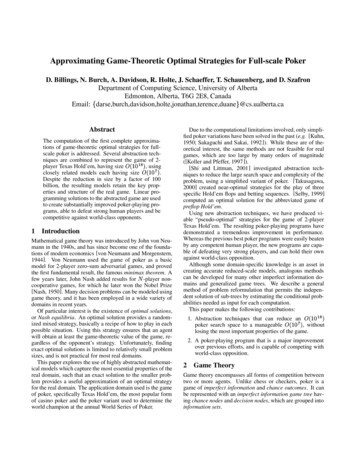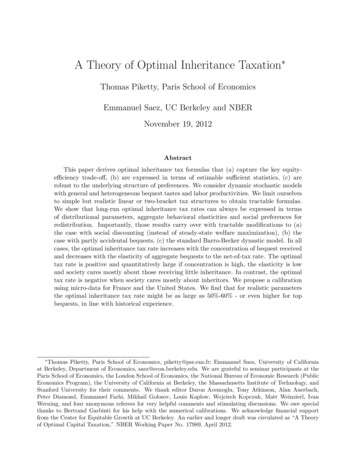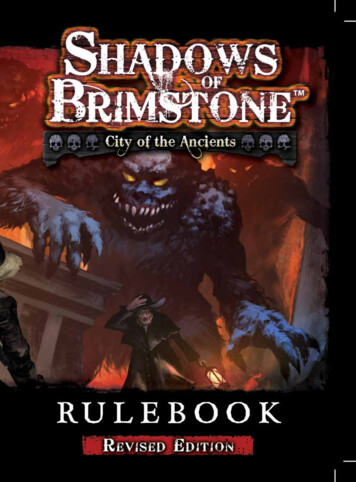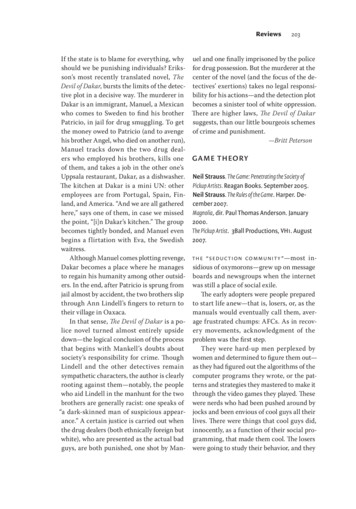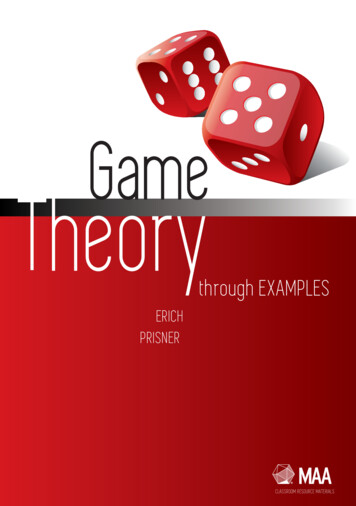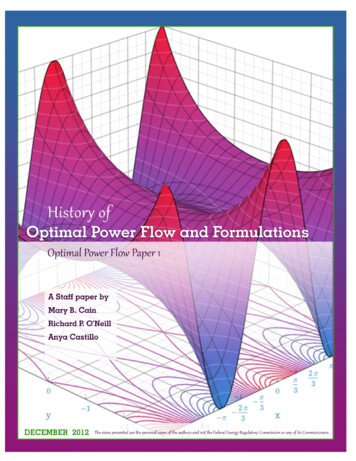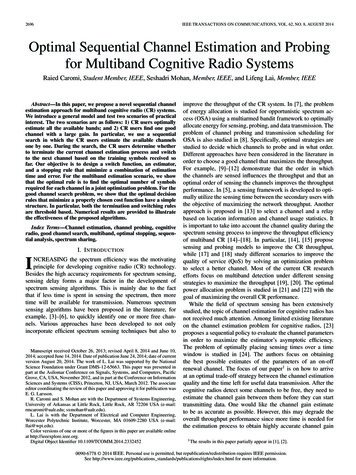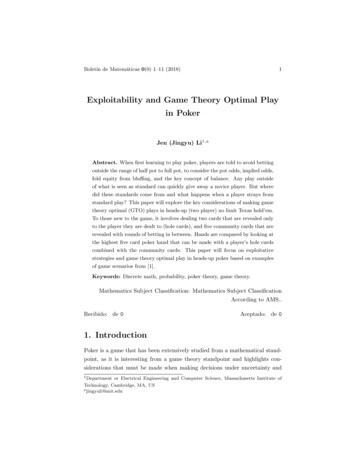
Transcription
Boletı́n de Matemáticas 0(0) 1–11 (2018)1Exploitability and Game Theory Optimal Playin PokerJen (Jingyu) Li1,aAbstract. When first learning to play poker, players are told to avoid bettingoutside the range of half pot to full pot, to consider the pot odds, implied odds,fold equity from bluffing, and the key concept of balance. Any play outsideof what is seen as standard can quickly give away a novice player. But wheredid these standards come from and what happens when a player strays fromstandard play? This paper will explore the key considerations of making gametheory optimal (GTO) plays in heads-up (two player) no limit Texas hold’em.To those new to the game, it involves dealing two cards that are revealed onlyto the player they are dealt to (hole cards), and five community cards that arerevealed with rounds of betting in between. Hands are compared by looking atthe highest five card poker hand that can be made with a player’s hole cardscombined with the community cards. This paper will focus on exploitativestrategies and game theory optimal play in heads-up poker based on examplesof game scenarios from [1].Keywords: Discrete math, probability, poker theory, game theory.Mathematics Subject Classification: Mathematics Subject ClassificationAccording to AMS.Recibido: de 0Aceptado: de 01. IntroductionPoker is a game that has been extensively studied from a mathematical standpoint, as it is interesting from a game theory standpoint and highlights considerations that must be made when making decisions under uncertainty and1 Departmentor Electrical Engineering and Computer Science, Massachusetts Institute ofTechnology, Cambridge, MA, USa jingyuli@mit.edu
2Jen (Jingyu) Lideals with expected value of strategies over time. It is a game with strategiesthat are not immediately intuitive and the value of those strategies are onlyseen over a large number of hands. To reduce complexity, this paper will focuson heads-up (two player) poker. To those new to the game, the game beginswith each player being dealt two cards which are hidden from the other player.A round of betting takes place, where there are four actions available to theplayers: check, bet, call, raise. A player can check or bet if no amount has yetbeen made in the current round of betting and a player can call (match theamount bet by the opponent) or raise (bet an additional amount on top of opponent’s bet) if the opponent bets. After the initial round of betting (pre-flop),the first three community cards (visible to both players) come out (flop). Another round of betting proceeds before the fourth card comes out and likewisebefore the fifth and final card. After all cards are out, there is one last round ofbetting before the players’ hands are compared (showdown). The complexityof poker arises from inferring probabilities through the many rounds of bettingand making decisions that consider events in the future. To understand themathematics behind playing optimally, we dissect the game into constrainedsub-problems, but the concepts derived through these examples are relevant inreal play.2. Pot OddsDefinition 2.1. We refer to a made hand as a poker hand that is alreadyguaranteed given a player’s hole cards and currently revealed community cards.Definition 2.2. We refer to a draw as a hand that can be made given certaincommunity cards come out.Example 2.1.Suppose Alice has A A and Bob has 5 6 . The community cards onthe turn (stage of game where 4 community cards have been revealed) areK 9 2 Q . Alice has a made hand of a pair of aces and Alice has a drawto a straight. Now if both players knew each other’s cards, they would agreethat if the last card is a 3 or 8 of any suit, Bob wins, otherwise Alice wins. Inthis world of perfect information, neither Alice nor Bob would bet on the river(when the last card comes out), because the winner would be clear.Now suppose there is already 100 in the pot and Alice can either checkBoletı́n de Matemáticas 0(0) 1-11 (2018)
Exploitability and Game Theory Optimal Play in Poker3or bet before the river card comes out. If Alice bets, Bob has the option tore-raise. There are 9 hearts remaining in the deck, which would give Bob aflush, beating Alice. The remaining 35 cards would allow Bob’s aces to hold.Suppose Alice is to act first. Since Alice is favored to win the hand, Alice hasreason to bet here. The amount she should bet is derived from calculatingexpected value (EV).The expected value is calculated as the probability of Alice winning the pottimes the new pot amount, deducted by the amount she bets. Note that thiscalculation emphasizes that as soon as Alice places a bet, she should no longerconsider that money to be her’s to lose, but rather part of the pot that she canwin (sunk cost).35(100 2x) x44 80 0.6xE(A) Note that if the probability of winning here is less than 21 , it is not profitableto bet. This however is complicated when we consider a real game where bothplayers do not have complete information and bluffing is a valid strategy.Also note that Alice’s EV is strictly increasing as her bet increases if Bobalways calls. Bob however, should only call if it is positive EV for him.9(100 2x) x44 20 0.6xE(B) Bob should thus only call if Alice’s bet is below around 33 orpre-betting. This1313of the potis what we refer to as pot odds. It is important to keepin mind that Bob can call larger bets or even re-raise because of something werefer to as implied odds, which take into consideration further betting on theriver due to it being unknown who has the better hand.3. Implied OddsImplied odds refer to the potential to make more money when a draw hits.Remember that we previously assumed both players had complete information.This is not true in a real game, which means betting on the river can beprofitable. In the case of our previous example, Alice does not know what BobBoletı́n de Matemáticas 0(0) 1-11 (2018)
4Jen (Jingyu) Lihas, so if Bob hits his flush, he can potentially make more off Alice than wasestimated by our EV calculations on the turn.Example 3.1.Let us continue with our previous example. If Bob hits a flush on the river, wewill assume that he knows correctly that he has the better hand (for now wewill ignore the possibility Alice has a higher flush, because the probability isrelatively low). Suppose Alice bet 50 on the turn and Bob called. The finalcard comes 7 . Now the pot is 200 and Alice acts first. Recall that the boardcurrently shows K 9 2 Q 7 . Now Alice doesn’t know what Bob has andbelieves it’s likely he has top pair (a king that pairs with the king showing onthe board). Alice thinks she can bet again to get value off of Bob. Here Bobcan fairly safely call or re-raise Alice’s bet.Let’s look at what Alice should do when the river card comes out. Supposeshe’s fairly certain Bob either hit his flush or just has the top pair on theboard. Estimating the probabilities of these two cases is more complicated(has to take into account what kinds of hands Bob generally plays and thehistory of actions on the current hand), but it’s fair to assume Bob has morehands involving kings in his range than two hearts.This means that if Bob knows Alice will bet on the river even if he hits hisflush, he is willing to call larger bets from Alice on the turn or even re-raise orbet if Alice checks.Definition 3.2. We refer to a player’s range as the hands he plays in a givensituation. In general, a player’s range does not change from hand to hand. Thatis not to say that the player should be predictable (see Section 4.2 regardingbalancing range).4. Game Theory Optimal Strategies4.1. Exploiting the OpponentIn actuality, the size of bets should not be proportional to how good your handis, nor should you only bet when you have a good hand, as that is exploitableby the opponent over time. In the previous sections, we looked at examplesconstrained to a single hand, in which case we only care about maximizing EVon that hand. However, poker is all about beating the odds over time, so it’sBoletı́n de Matemáticas 0(0) 1-11 (2018)
Exploitability and Game Theory Optimal Play in Poker5important to realize that a strategy optimized for a single hand may not beoptimal or even profitable in the long run.As a simple but realistic example, suppose your opponent only bets andraises hands that they think will win the pot, but still calls some of your betswith weaker hands (this is not an uncommon type of play from risk-adversebeginners). It’s easy to exploit a player like this by simply using a strategywhich folds to every bet or raise the opponent makes and still betting our goodhands. Of course, eventually the opponent will catch on and counter-exploitby bluffing their hands if they know we will fold. On this end of the spectrum,suppose a player bluffs too many hands. To exploit this play style, we canafford to play a larger portion of hands and make large profits when we hit atop hand.This leads us to the idea of balancing our range, or deciding the hands weplay in a given situation such that an opponent cannot exploit our strategy.4.2. BalanceTo play non-exploitable game theory optimal (GTO) poker, ranges should be“balanced”, meaning Often this means that we have a variety of possible handsin the eyes of the opponent in any situation. This means adding in a range ofhands with which you bluff and not betting only when you have a good handor betting a larger amount when you have the winning hand.Definition 4.1. We define defensive value as the expected value of a strategy against the opponent’s most exploitative strategy. Note the differencebetween this value and EV as we’ve previously looked at is that this assumesthe opponent knows how we play and can exploit any patterns over time in ourstrategy.A more rigorous definition of balanced strategy is minimizing the gap between defensive value (Definition 4.1) and expected value. In other words, theexpected payoff of the strategy in a given hand should not change over time asyour strategy is gradually exposed to your opponent: your opponent plays thesame way regardless whether your strategy is known to them.Definition 4.2. A pure strategy dictates a player’s action in any situationi.e. the player will always make the same decision under given circumstances.Boletı́n de Matemáticas 0(0) 1-11 (2018)
6Jen (Jingyu) LiDefinition 4.3. A mixed strategy is one in which the player assigns a probability distribution over all pure strategies (Definition 4.2).Definition 4.4. Nash equilibrium is a strategy set in a multi-player gamewhere neither player alone can increase their payoff. Because of this, it is astable point where neither player wants to deviate from their current strategy.Definition 4.5. A game in which the sum of all players’ scores is equal to 0is called a zero-sum game.Definition 4.6. Indifference refers to a game state where a player gets thesame expected payoff regardless what strategy is chosen.Definition 4.7. An indifference threshold is a value for a parameter thata player can choose to force indifference (Definition 4.6) on the opponent.It is a known fact of game theory that all multi-player games with finitepayout matrices have at least one Nash equilibrium (Definition 4.4). Additionally, poker is a zero-sum game (Definition 4.5) and it is known that all zero-sumtwo-player games have an optimal strategy as long as mixed strategies (Definition 4.3) are allowed. This leads to the concept of indifference (Definition 4.6.By setting expected payoff equations equal to each other, we can obtain values for parameters that force a player to be indifferent to choosing amongstrategies. The value of the parameter found by solving these equations is anindifference threshold (Definition 4.7). Let us take a look at the followingexample.Example 4.8.Suppose Bob has three of a kind and on a particular board is only scared ofAlice having a flush. Let us assume that Alice has a flush here 20% of the time.How often can Alice bluff? For this example suppose there is 300 in the potand Alice can choose to bet a fixed amount of 100. To keep it simple, we willsay Bob either calls or folds when Alice bets.How often should Alice bluff here? If Alice bets 100, Bob can pay 100to potentially win 400. Suppose Alice only bets when she has the flush. Bobcan exploit this strategy by folding every time Bob bets, preventing him fromgetting any additional value from hitting his flush and taking the pot 80% ofthe time. Alice has a defensive value of 0.2 · 300 60 with this strategy,where she only profits when she has the flush. Now suppose Alice bets all herBoletı́n de Matemáticas 0(0) 1-11 (2018)
Exploitability and Game Theory Optimal Play in Poker7hands here. 20% of the time she has the flush and the other 80% of the timeshe has nothing. If Bob calls, his EV is 0.8 · 400 100 220 and if he folds,his EV is 0, so Bob will exploit Alice’s strategy here by always calling. Thedefensive value of Alice’s strategy is 0.2 · 400 100 20.The two strategies mentioned so far (always checking a dead hand andalways betting a dead hand) are what are known as pure strategies (Definition 4.2) and neither is optimal for Alice in this situation. We know this,because both are exploitable – Bob alone can change his strategy and increasehis payoff. This indicates we are not at a equilibrium point.Now, we explore mixed strategies. Let P hA, bluffi be faction of all handsAlice has on the river that she bluffs with. Bob’s EV for calling when Alicebets can be computed asEB hB, calli P hA, bluffi· 400 1000.2 P hA, bluffiAlternatively, Bob can fold when Alice bets.EB hB, foldi 0Alice’s EV can be computed asEA hB, calli 0.2· 400 1000.2 P hA, bluffiEA hB, foldi (0.2 P hA, bluffi) · 300Alice’s strategy is least exploitable when Bob’s EV for calling and folding areequal (i.e. Bob is not able to change his strategy to exploit Alice even ifover time he figures out how often Alice bluffs).
However, poker is all about beating the odds over time, so it’s Bolet n de Matem aticas 0(0) 1-11 (2018) Exploitability and Game Theory Optimal Play in Poker 5 important to realize that a strategy optimized for a single hand may not be optimal or even pro table in the long run. As a simple but realistic example, suppose your opponent only bets and raises hands that they think will win the .
